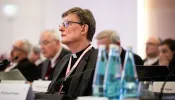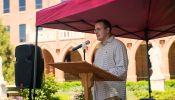Yesterday we celebrated the Cross of Christ, the instrument of our salvation, which reveals the mercy of our God in all its fullness. The Cross is truly the place where God’s compassion for our world is perfectly manifested. Today, as we celebrate the memorial of Our Lady of Sorrows, we contemplate Mary sharing her Son’s compassion for sinners. As Saint Bernard declares, the Mother of Christ entered into the Passion of her Son through her compassion (cf. Homily for Sunday in the Octave of the Assumption). At the foot of the Cross, the prophecy of Simeon is fulfilled: her mother’s heart is pierced through (cf. Lk 2:35) by the torture inflicted on the innocent one born of her flesh. Just as Jesus cried (cf. Jn 11:35), so too Mary certainly cried over the tortured body of her Son. Her self-restraint, however, prevents us from plumbing the depths of her grief; the full extent of her suffering is merely suggested by the traditional symbol of the seven swords. As in the case of her Son Jesus, one might say that she too was led to perfection through this suffering (cf. Heb 2:10), so as to make her capable of receiving the new spiritual mission that her Son entrusts to her immediately before "giving up his spirit" (cf. Jn 19:30): that of becoming the mother of Christ in his members. In that hour, through the figure of the beloved disciple, Jesus presents each of his disciples to his Mother when he says to her: Behold your Son (cf. Jn 19:26-27).
Today Mary dwells in the joy and the glory of the Resurrection. The tears shed at the foot of the Cross have been transformed into a smile which nothing can wipe away, even as her maternal compassion towards us remains unchanged. The intervention of the Virgin Mary in offering succor throughout history testifies to this, and does not cease to call forth, in the people of God, an unshakable confidence in her: the Memorare prayer expresses this sentiment very well. Mary loves each of her children, giving particular attention to those who, like her Son at the hour of his Passion, are prey to suffering; she loves them quite simply because they are her children, according to the will of Christ on the Cross.
The psalmist, seeing from afar this maternal bond which unites the Mother of Christ with the people of faith, prophesies regarding the Virgin Mary that "the richest of the people … will seek your smile" (Ps 44:13). In this way, at the instigation of the inspired word of Scripture, Christians have always sought the smile of Our Lady, this smile which medieval artists were able to represent with such marvelous skill and to show to advantage. This smile of Mary is for all; but it is directed quite particularly to those who suffer, so that they can find comfort and solace therein. To seek Mary’s smile is not an act of devotional or outmoded sentimentality, but rather the proper expression of the living and profoundly human relationship which binds us to her whom Christ gave us as our Mother.
To wish to contemplate this smile of the Virgin, does not mean letting oneself be led by an uncontrolled imagination. Scripture itself discloses it to us through the lips of Mary when she sings the Magnificat: "My soul glorifies the Lord, my spirit exults in God my Savior" (Lk 1:46-47). When the Virgin Mary gives thanks to the Lord, she calls us to witness. Mary shares, as if by anticipation, with us, her future children, the joy that dwells in her heart, so that it can become ours. Every time we recite the Magnificat, we become witnesses of her smile. Here in
In the smile of the most eminent of all creatures, looking down on us, is reflected our dignity as children of God, that dignity which never abandons the sick person. This smile, a true reflection of God’s tenderness, is the source of an invincible hope. Unfortunately we know only too well: the endurance of suffering can upset life’s most stable equilibrium, it can shake the firmest foundations of confidence, and sometimes even leads people to despair of the meaning and value of life. There are struggles that we cannot sustain alone, without the help of divine grace. When speech can no longer find the right words, the need arises for a loving presence: we seek then the closeness not only of those who share the same blood or are linked to us by friendship, but also the closeness of those who are intimately bound to us by faith. Who could be more intimate to us than Christ and his holy Mother, the Immaculate One? More than any others, they are capable of understanding us and grasping how hard we have to fight against evil and suffering. The Letter to the Hebrews says of Christ that he "is not unable to sympathize with our weaknesses; for in every respect he has been tempted as we are" (cf. Heb 4:15). I would like to say, humbly, to those who suffer and to those who struggle and are tempted to turn their backs on life: turn towards Mary! Within the smile of the Virgin lies mysteriously hidden the strength to fight against sickness, in support of life. With her, equally, is found the grace to accept without fear or bitterness to leave this world at the hour chosen by God.
How true was the insight of that great French spiritual writer, Dom Jean-Baptiste Chautard, who in L’âme de tout apostolat, proposed to the devout Christian to gaze frequently "into the eyes of the Virgin Mary"! Yes, to seek the smile of the Virgin Mary is not a pious infantilism, it is the aspiration, as Psalm 44 says, of those who are "the richest of the people" (verse 13). "The richest", that is to say, in the order of faith, those who have attained the highest degree of spiritual maturity and know precisely how to acknowledge their weakness and their poverty before God. In the very simple manifestation of tenderness that we call a smile, we grasp that our sole wealth is the love God bears us, which passes through the heart of her who became our Mother. To seek this smile, is first of all to have grasped the gratuitousness of love; it is also to be able to elicit this smile through our efforts to live according to the word of her Beloved Son, just as a child seeks to elicit its mother’s smile by doing what pleases her. And we know what pleases Mary, thanks to the words she spoke to the servants at
Mary’s smile is a spring of living water. "He who believes in me", says Jesus, "out of his heart shall flow rivers of living water" (Jn 7:38). Mary is the one who believed and, from her womb, rivers of living water have flowed forth to irrigate human history. The spring that Mary pointed out to Bernadette here in
Christ imparts his salvation by means of the sacraments, and especially in the case of those suffering from sickness or disability, by means of the grace of the sacrament of the sick. For each individual, suffering is always something alien. It can never be tamed. That is why it is hard to bear, and harder still – as certain great witnesses of Christ’s holiness have done – to welcome it as a significant element in our vocation, or to accept, as Bernadette expressed it, to "suffer everything in silence in order to please Jesus". To be able to say that, it is necessary to have travelled a long way already in union with Jesus. Here and now, though, it is possible to entrust oneself to God’s mercy, as manifested through the grace of the sacrament of the sick. Bernadette herself, in the course of a life that was often marked by sickness, received this sacrament four times. The grace of this sacrament consists in welcoming Christ the healer into ourselves. However, Christ is not a healer in the manner of the world. In order to heal us, he does not remain outside the suffering that is experienced; he eases it by coming to dwell within the one stricken by illness, to bear it and live it with him. Christ’s presence comes to break the isolation which pain induces. Man no longer bears his burden alone: as a suffering member of Christ, he is conformed to Christ in his self-offering to the Father, and he participates, in him, in the coming to birth of the new creation.
Without the Lord’s help, the yoke of sickness and suffering weighs down on us cruelly. By receiving the sacrament of the sick, we seek to carry no other yoke that that of Christ, strengthened through his promise to us that his yoke will be easy to carry and his burden light (cf. Mt 11:30). I invite those who are to receive the sacrament of the sick during this Mass to enter into a hope of this kind.
The Second Vatican Council presented Mary as the figure in whom the entire mystery of the Church is typified (cf. Lumen Gentium 63-65). Her personal journey outlines the profile of the Church, which is called to be just as attentive to those who suffer as she herself was. I extend an affectionate greeting to those working in the areas of public health and nursing, as well as those who, in different ways, in hospitals and other institutions, are contributing to the care of the sick with competence and generosity. Equally, I should like to say to all the hospitaliers, the brancardiers and the carers who come from every diocese in
The service of charity that you offer is a Marian service. Mary entrusts her smile to you, so that you yourselves may become, in faithfulness to her son, springs of living water. Whatever you do, you do in the name of the Church, of which Mary is the purest image. May you carry her smile to everyone!
To conclude, I wish to join in the prayer of the pilgrims and the sick, and to pray with you a passage from the prayer to Mary that has been proposed for this Jubilee celebration:
"Because you are the smile of God, the reflection of the light of Christ, the dwelling place of the Holy Spirit,
Because you chose Bernadette in her lowliness, because you are the morning star, the gate of heaven and the first creature to experience the resurrection,
Our Lady of Lourdes", with our brothers and sisters whose hearts and bodies are in pain, we pray to you!











